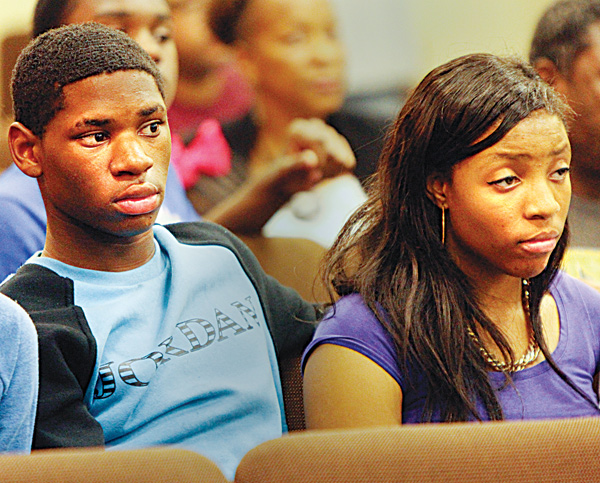Youngstown seminar aims to improve police relations with minorities


Jamon West, 14, and Sade Poindexter, 17, both of Youngstown, listen intently to advice from police about how to respond when picked up to avoid a confrontation.
By Sean Barron
YOUNGSTOWN
Mossco DuBose vividly recalled the morning several decades ago when he got pulled over while driving south on state Route 11 to pay a fine in Austintown.
“I reached into the glove compartment and I heard a click, and then I was looking down the barrel [of the officer’s gun],” he remembered.
The frightening encounter caught him off guard because the officer had no reason to draw his weapon, DuBose explained, adding that he received only a written warning for having a burned-out taillight.
DuBose said he understands that police officers have a difficult and risky job. Even so, they should not be overly aggressive toward the vast majority of people who have committed minor infractions or done nothing wrong, he continued.
Nevertheless, DuBose gained greater insight into such situations from the perspective of law enforcement, courtesy of having attended Tuesday’s seminar, “What to Do When You’re Stopped by the Police,” at Metro Assembly of God, 2530 South Ave., on the South Side.
Ernie Brown, a Vindicator regional editor and columnist, moderated the 90-minute panel discussion. Sponsoring the gathering were the Community Initiative to Reduce Violence organization and the Alliance for Congregational Transformation Influencing Our Neighborhoods.
Panelists were Guy Burney, CIRV’s executive director; former Youngstown Police Chief Jimmy Hughes; current Chief Robin Lees; and retired Detective Sgt. Delphine Baldwin-Casey.
The gathering’s main purpose was to take steps and develop strategies to improve the climate and relations between law enforcement and minority communities, Burney noted.
Serving as the main impetus for the event was the Aug. 9 fatal shooting of Michael Brown, an 18-year-old unarmed black man, by a white police officer in Ferguson, Mo., and the aftermath.
One way to avoid situations such as the Ferguson tragedy is to push for better relations between police and the communities they serve, Baldwin-Casey said. She added that it’s also imperative that officers are sensitive toward people who are different from them, and that the public better understands the roles authorities play.
On the other hand, many people don’t understand the concept of probable cause, she continued. She cited an example of someone who may have done nothing wrong, yet is stopped because of acting suspiciously or fitting the description of a person who had committed a recent crime.
Hughes recalled when community policing played a pivotal part in establishing closer bonds of trust between residents and officers.
Lees noted that his department will be forming a community-policing unit that will contain seven officers, one for each city ward. The effort should get underway early next year, he said.
During the question-and-answer portion, one attendee wanted to know the extent to which an officer can legally question someone during a traffic stop.
Lees said that after ascertaining the motorist’s information such as name, date of birth and proof of insurance, the situation usually dictates the line and degree of questioning. The officer likely will further question a person who’s evasive or uncooperative than someone who’s compliant, he explained.
Another person asked about the best place in a vehicle to store a piece of identification, and Lees said a purse or glove compartment. Officers, however, are trained to assess for potential threats and suspicious movements during traffic stops, so vehicle occupants should alert the officer when reaching into the glove compartment, he cautioned.
Additional practical advice for handling inherently tense situations came from 16-year-old Jairus DuBose, an Ursuline High School junior who’s also Mossco DuBose’s grandson.
“If you get pulled over, don’t escalate the situation. If you run a stop sign, don’t talk back. Respect the officer.”
 43
43
